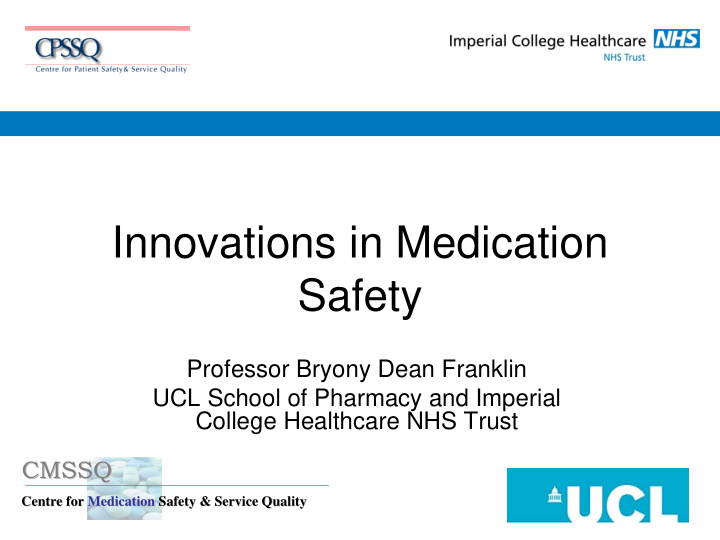



Innovations in Medication Safety Professor Bryony Dean Franklin UCL School of Pharmacy and Imperial College Healthcare NHS Trust CMSSQ CMSSQ Centre for Centre for Medication Medication Safety & Service Quality Safety & Service Quality
Most common healthcare intervention
But...
So what’s the solution?
The Prescribing Improvement Model Study (PIMs) Improving patient safety through providing feedback to junior doctors on prescribing errors
First... identify root causes 8
Quotes “Also for something like aspirin, I know most pharmacists would just add that on to the drug chart and PNC [prescriber not contacted], so not contact the prescriber because it’s so small you wouldn’t contact the doctor just to say, oh it should be enteric coated or, oh it should be dispersible and you didn’t write that on..A lot of the time we’ll change, we’ll add modified release and, without probably telling the doctor”. (Pharmacist) 9
Quotes “And there’s another key issue here as well especially if you’re in an area where there’s a lot of doctors rotating, sometimes that phenytoin prescription is written by Doctor X, Doctor X has gone home so I have to go to Doctor Y and get them to change it and that’s fine, they learn something new, but Doctor X who wrote the prescription doesn’t know anything about it”. (Pharmacist) 10
Is this the problem?
Prescribing Improvement Model Aim • To develop, test the feasibility, and evaluate a practical, low-cost intervention to provide feedback to junior doctors on prescribing errors and increase patient safety. Three component objectives: 1. To encourage prescribers to identify themselves when prescribing 2. To increase the feedback given by pharmacists to individual prescribers on their prescribing errors 3. To introduce group feedback to junior doctors on common prescribing errors
Focus group with FY1s
And what do the public think? “…it’s OK to screw up once but there ought to be a process that says you’ve screwed up once and we’re going to correct it so that it doesn’t happen again. What’s unforgivable is if you’ve got the ability to go on screwing up time and time again” Patient focus group participant
1. Prescriber Identification 16
Plan – Do – Study – Act
Plan – Do – Study – Act
Fortnightly data • Percentage of inpatient medication orders written FY1s where the prescriber is identifiable 19
Fortnightly data • Percentage of inpatient medication orders written FY1s where the prescriber is identifiable 20
2. Individual feedback • Pharmacists asked to: – Identify individual prescriber – Contact individual prescriber – Tell them an error made – Suggest how to avoid the error • Publicity and education • Accompanied visits 21
3. “Prescribing tips” • Sent fortnightly • “Spot the error” • Discusses one or two errors in more depth • Readable (i.e. not much to read!) • Identify and link to relevant prescribing resources 22
3. “Prescribing tips” - topics • Unusual frequencies • Oral opioids • Treating DVTs • Insulin • Laxatives • Inhalers 23
Evaluation • Process measures • Weekly audit on identifiable prescribers • Pharmacists assessed for feedback provision • Outcome measures • Prevalence of Intervention and prescribing errors control hospitals • Questionnaire • Focus groups Intervention hospital 24
Results • Questionnaire results from April 2013 We asked all junior doctors if they agreed with the statement: “I am aware of all major prescribing errors I make” 77% agreed / strongly agreed The complementary statement to pharmacists: “I believe FY1s are aware of all major prescribing errors they make” 31% agreed / strongly agreed 25
Reflections • Need to take time to LISTEN • Need a rigorous approach 26
Hopefully...
Other innovations
Smartphone apps • Point of care antimicrobial prescribing support to health care professionals
Dr-CARD
Pharmacists on ward rounds • Pharmacists who attend consultant-led ward rounds make more interventions per patient than those who provide only a standard ward pharmacy service.
“Check and Correct”
And what next..?
Hospital electronic prescribing
Hospital electronic prescribing No EP 1 system respondents Some form of EP More than 1 system
Hospital electronic prescribing and medication adminstration
“IMPRESS” study How would they How do hospital LIKE to engage with inpatients engage medication safety? with medication safety ? How does this differ between paper- What interventions based and are needed? electronic medication records?
Further app developments • Cross-sector smartphone applications: – point of care antimicrobial prescribing support – antimicrobial therapy information to patients – linking whole health system • Collaboration with Public Health England (ex-HPA) • Grant from Imperial College Healthcare Charity
Better use of our workforce
The solution?
The solution? Patients Understanding Interactions behaviour Antibiotic stewardship Use of Unintended and patient information consequences? safety
Acknowledgements 44
Recommend
More recommend